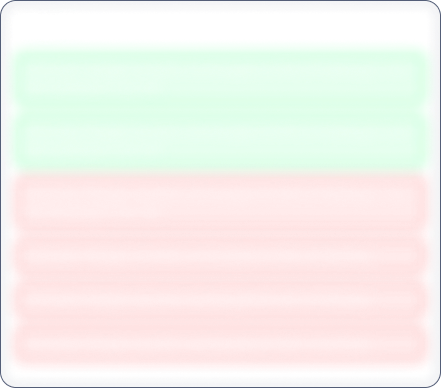Year End Sale 50% off
Iware Supplychain Services

No Data Available
Investor Sentiment
Iware Supplychain Services Share price and Fundamental Analysis
Key Metrics
Stock Returns
Stock Heatmap

No Stocks
Smart Score

Unlock Smart Score
See Detailed Analysis & Insights


Unlock Insights
See Detailed Analysis & Insights
Technicals
Returns Calculator
If you would have investedResearch Report
No Research Report
Corporate Action

No Data Available
Financials
Key Ratios
ROE
Avg ROE (3 Yrs) : NaN%
ROCE
Avg ROCE (3 Yrs) : NaN%
ROA
Avg ROA (3 Yrs) : NaN%
NPM
Avg NPM (3 Yrs) : NaN%
Dividend History
5 Year FactSheet
Documents

No Data Available
News
Iware Supplychain Services Management and History
Company Management


Unlock Management Data
See Detailed Analysis & Insights
Company History
M/s Iware Supplychain Services Private Limited was originally incorporated as a Private Limited Company dated January 17, 2018 with the Registrar of Companies, Central Registration Centre. The status of the Company has been changed to a Public Limited Company in 2024 reporting the name of the Company as 'Iware Supplychain Services Limited' via fresh Certificate of Incorporation dated November 27, 2024 issued by the ROCs, Central Registration Centre.
Company's strength lies in its diversified service range, which spans in five different type of services (i) Warehousing (including third-party logistics (3PL) and Carrying & Forwarding Agent), (ii) Transportation (Including Carrying & Forwarding Agent) (iii) Rake Handling Services and (iv) Business Auxiliary Services (v) Rental Income. The fleets include 47 owned vehicles, and any further requirements are outsourced either on lease from third party or from the Promoter Group Company. The Company operate through a network of branch offices located in Gujarat, West Bengal, Uttar Pradesh, Rajasthan, Punjab, Haryana, and Delhi. It work with clients across various industries, including Fast Moving Consumer Goods (FMCG), Auto components, Sanitary-ware and many more. This shows the strength of the Company handling and providing end to end logistic solutions to different industries. The technological systems that Company uses for managing the logistics operations are provided by clients to improve the service quality, consistency and increase the operating efficiency.
The Company is planning a fresh issue equity shares upto 28,56,000 of face value of Rs 10 each.
Iware Supplychain Services Share Price
Iware Supplychain Services share price reflects investor sentiment toward the company and is impacted by various factors such as financial performance, market trends, and economic conditions. Share price is an indicator which shows the current value of the company's shares at which buyers or sellers can transact.
Iware Supplychain Services Market Cap
Market capitalization of Iware Supplychain Services indicates the total value of its outstanding shares. Marketcap is calculated by multiplying share price and outstanding shares of the company. It is a helpful metric for assessing the company's size and market Valuation. It also helps investors understand how Iware Supplychain Services is valued compared to its competitors.
Iware Supplychain Services PE Ratio
Iware Supplychain Services PE ratio helps investors understand what is the market value of each stock compared to Iware Supplychain Services 's earnings. A PE ratio higher than the average industry PE could indicate an overvaluation of the stock, whereas a lower PE compared to the average industry PE could indicate an undervaluation.
Iware Supplychain Services PEG Ratio
The PEG ratio of Iware Supplychain Services evaluates its PE ratio in relation to its growth rate. A PEG ratio of 1 indicates a fair value, a PEG ratio of less than 1 indicates undervaluation, and a PEG ratio of more than 1 indicates overvaluation.
Iware Supplychain Services ROE (Return on Equity)
Return on Equity (ROE) measures how effectively Iware Supplychain Services generates profit from shareholders' equity. A higher ROE of more than 20% indicates better financial performance in terms of profitability.
Iware Supplychain Services ROCE (Return on Capital Employed)
Return on Capital Employed (ROCE) evaluates the profitability of Iware Supplychain Services in relation to its capital employed. In simple terms, ROCE provides insight to investors as to how well the company is utilizing the capital deployed. A high ROCE of more than 20% shows that the business is making profitable use of its capital.
Iware Supplychain Services Total Debt
Total debt of Iware Supplychain Services shows how much the company owes to either banks or individual creditors. In simple terms, this is the amount the company has to repay. Total debt can be a very useful metric to show the financial health of the company. Total debt more than equity is considered to be a bad sign.
Iware Supplychain Services Debt to Equity Ratio
The Debt-to-Equity (DE) ratio of Iware Supplychain Services compares its total debt to shareholders' equity. A higher Debt to Equity ratio could indicate higher financial risk, while a lower ratio suggests that the company is managing its debt efficiently.
Iware Supplychain Services CAGR (Compound Annual Growth Rate)
CAGR shows the consistent growth rate of Iware Supplychain Services over a specific period, whether it is over a month, a year, or 10 years. It is a key metric to evaluate the company’s long-term growth potential. Main metrics for which CAGR is calculated are net sales, net profit, operating profit, and stock returns.
Iware Supplychain Services Technical Analysis
Technical analysis of Iware Supplychain Services helps investors get an insight into when they can enter or exit the stock. Key components of Iware Supplychain Services Technical Analysis include:
Support Levels (S1, S2, S3)
There are usually multiple support levels, but the main support levels for a stock are S1, S2, S3. Support levels indicate price points where stock might get support from buyers, helping the stock stop falling and rise.
Resistance Levels (R1, R2, R3)
There are usually multiple resistance levels, but the main resistance levels for a stock are R1, R2, R3. Resistance levels represent price points where Iware Supplychain Services shares often struggle to rise above due to selling pressure.
Iware Supplychain Services Dividends
Dividends refer to the portion of the company’s profits distributed to its shareholders. Dividends are typically paid out in cash and reflect Iware Supplychain Services ’s financial health and profitability.
Iware Supplychain Services Bonus Shares
Bonus shares are usually given by companies to make the stock more affordable, increase liquidity, boost investor confidence, and more.
Iware Supplychain Services Stock Split
Stock split increases the number of its outstanding shares by dividing each existing share into multiple shares. When the company offers a stock split, the face value of the stock reduces in the same proportion as the split ratio.
Iware Supplychain Services Financials
The financials of Iware Supplychain Services provide a complete view to investors about its net sales, net profit, operating profits, expenses, and overall financial health. Investors can analyze financial data to assess the company’s stability and also understand how the company has been growing financially.
Iware Supplychain Services Profit and Loss Statements
The profit and loss statement of Iware Supplychain Services highlights its net sales, net profit, total expenditure, and operating profits in the current financial year. This Profit and Loss statement is crucial for evaluating the profitability and financial stability of Iware Supplychain Services .
Iware Supplychain Services Balance Sheet
The balance sheet presents a snapshot of Iware Supplychain Services ’s assets, liabilities, and equity of shareholders, providing insights into the financials of the company.
Iware Supplychain Services Cashflow Statements
Cashflow statements track the company's cash inflows and outflows over a period. It is an essential tool for understanding how well the company manages its liquidity and finances.


